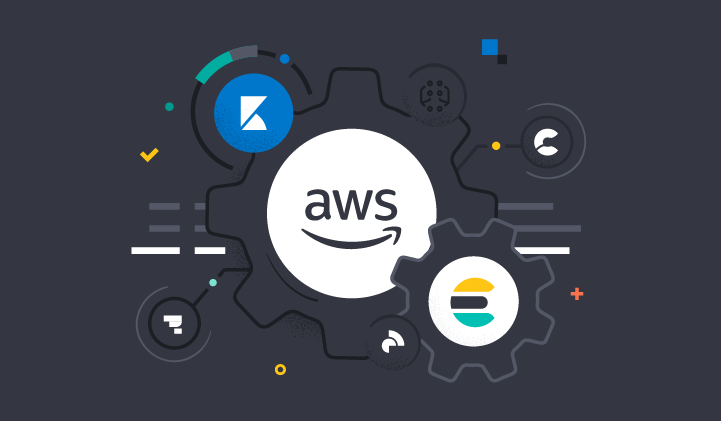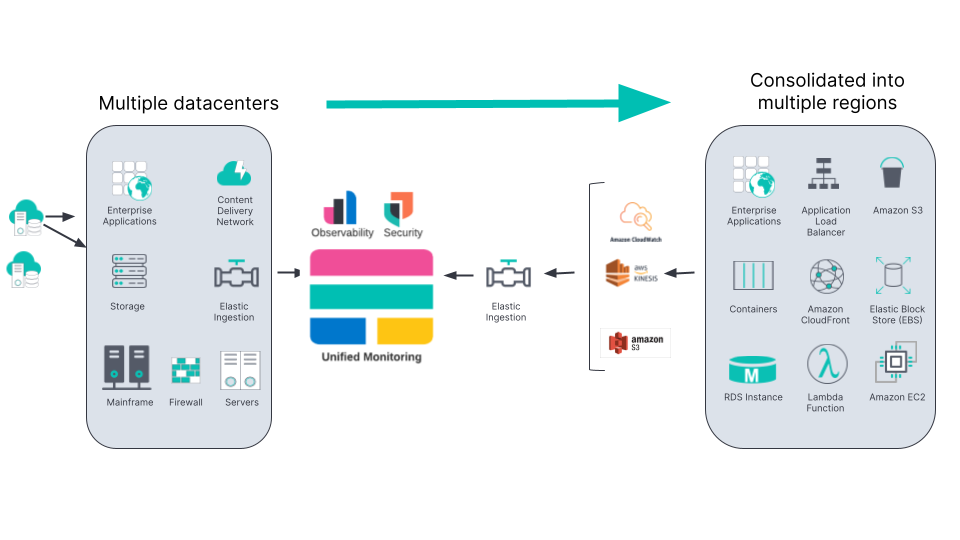Elastic and AWS: Accelerating the cloud migration journey

Cloud offerings deliver cost-efficiency and agility; however, the migration process and management complexity can pose challenges. Elastic enables organizations to monitor, analyze, and protect their Amazon Web Services (AWS) and on-premises workloads within a single unified platform — at every stage of their cloud adoption journey — even as they migrate workloads. This can help ensure time-and-cost savings while reducing risk.
In this blog, we will discuss how Elastic and AWS work together to accelerate the workload migration journey and ensure a smooth transition to the cloud.
Benefits and challenges of cloud adoption
There are many business drivers behind digital transformation, from delivering better customer outcomes and improved employee productivity to supporting application modernization and AI workloads. Organizations also look to the cloud to deliver scalability and meet strict compliance and security guidelines while simplifying their data architecture. The ultimate goals behind cloud adoption are a faster time to market, uncovering better insights, and reducing overall IT costs.
However, the rewards of moving to the cloud are not without risk. Common challenges faced by organizations include:
- Complexity: Often thousands of microservices workloads need to be migrated and a lack of visibility into complex dependencies can present obstacles to addressing technical issues and making key decisions.
- Time: The typical migration is a multi-year process and has immense pressure to be completed on time and within budget.
- Right-sizing: Prior to migration, it’s essential to inventory on-premises workloads and properly size resource requirements in the cloud (how much RAM, which compute instances, etc.) to avoid unexpected charges and budget overages later on.
- Re-architecture: Applications may need to be re-architected for the cloud. This is especially true for legacy monolithic application architectures that do not lend themselves easily to the scale and agility benefits of the cloud through containerization, orchestration, serverless, and other cloud-native technologies.
- Performance: Applications may experience slowdowns or even downtime as a result of the migration. Data gravity, interoperability, and dependencies on non-cloud apps are often key concerns in this area.
- Security: Data exposure, loss, and external attacks must also be taken into account.
Ensuring a successful and secure cloud migration
Let’s take an end-to-end look at the cloud migration journey.
Visibility across migration phases
In order to migrate to the cloud with confidence, it is essential to have a comprehensive understanding of application and infrastructure resources across AWS and on-premises environments. Elastic delivers unified hybrid and multi-cloud visibility at every stage of the cloud migration process.
- Pre-migration: Visibility into the on-premises application infrastructure can help build a full understanding of both microservices-based and monolithic applications. In the pre-migration phase, Elastic enables visualization of application architecture and dependencies using service mapping, real user experience monitoring of on-premises web applications, pre-migration cost analysis, application portfolio assessment, and right sizing.
- During migration: Hybrid environment monitoring during migration can help validate performance and proactively identify user experience issues, such as high latency or errors, that often result from migrating complex on-premises architectures to a more distributed cloud infrastructure. Distributed tracing and service dependency mapping is especially valuable for a comprehensive understanding of microservices architectures (MSA) and third-party dependencies within the application portfolio.
- Post-migration: Post-migration checks and balances are an essential component of the migration journey. With Elastic, organizations can set up alerting and incident management, monitor uptime and availability for all cloud resources as they come online, troubleshoot performance and other issues, understand trends, and perform cost optimization based on cloud usage.
Elastic delivers multiple tools and services to help automate and accelerate these cloud migration tasks.
Observability in the cloud: faster time to value with curated app
Given the added complexity of managing multiple cloud and on-premises platforms, it is no surprise observability is becoming a critical business initiative and the number one challenge for DevOps teams according to research from the Enterprise Management Associates (EMA) group. The research also indicated DevOps teams spend 50% of their time determining the root cause of problems and this could be magnified as organizations introduce different cloud, software, and architecture choices into their environment. The right methodology has to be established for this complex transformation, along with the right technological choices. Teams that deploy observability are able to develop 70% faster and maintain increased product velocity with four times the number of features, according to the EMA group research.
Elastic Observability delivers unified visibility across the entire cloud and on-premises ecosystem so practitioners can monitor and react to events happening anywhere in their environment. Elastic brings logs, metrics, and APM traces together, at scale in a single stack with built-in machine learning to help detect issues and surface root causes before users are even aware of them. Elastic Observability delivers:
- Centralized log analysis for infrastructure and application logs, and other structured events
- Infrastructure monitoring of logs, metrics, and uptime for all infrastructure components
- Application performance monitoring across application logs, metrics, distributed tracing, error tracking, service dependency mapping, and API health
- End user experience monitoring delivering real user monitoring, website availability monitoring, and browser-based synthetic monitoring
- Cloud migration monitoring throughout every phase of the migration journey
Security in the cloud: a shared responsibility model
The same observability data can also be used for extended detection and response (XDR) to drive mean time to detection towards zero. Elastic Security automates security detection and prevention tasks so organizations can focus on innovation and strategic business goals. Within the shared responsibility model of the AWS Well-Architected Framework, Elastic provides the tools for these operational security tasks, while AWS provides a secure infrastructure to run on, composed of the hardware, software, networking, and facilities that run AWS Cloud services.

Elastic and AWS: better together
Elastic has been certified as an AWS ISV Workload Migration Program (WMP) partner to support the migration of self-managed on-premises Elasticsearch or ELK workloads to Elastic Cloud on AWS. Elastic’s methodology provides customers with a prescriptive and repeatable approach for accelerating migration adoption and is directly aligned with migration guidance and best practices published by AWS, including the AWS Well-Architected Framework and AWS Migration Acceleration Program. Through the AWS WMP program, Elastic customers can further take advantage of onboarding guidance, migration resources, and AWS infrastructure credits and funding assistance to achieve their business goals and accelerate their cloud journey.
Get started today
Elastic is working closely with AWS to help organizations realize cloud benefits faster. View the marketplace listing to deploy Elastic Cloud on AWS. Learn more about the steps required for migrating to Elastic Cloud, migrating Elasticsearch data, and Elastic integrations with AWS.
Or, start your own 7-day free trial by signing up via AWS Marketplace and quickly spin up a deployment in minutes on any of the Elastic Cloud regions on AWS around the world. Your AWS Marketplace purchase of Elastic will be included in your monthly consolidated billing statement and will draw against your committed spend with AWS.
The release and timing of any features or functionality described in this post remain at Elastic's sole discretion. Any features or functionality not currently available may not be delivered on time or at all.

